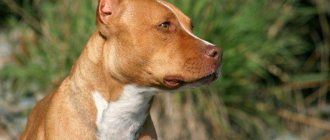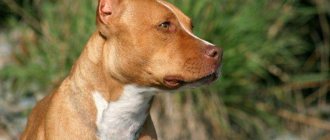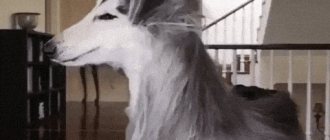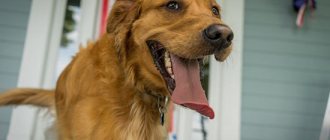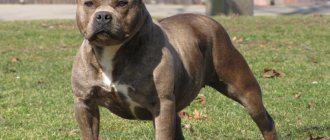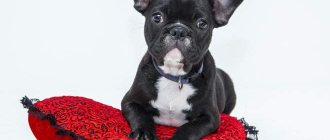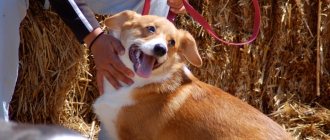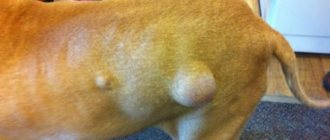Pitbull Writer is a new breed of Russian selection. This dog, similar to a pit bull in appearance, has a completely different character. Dog handlers have eliminated all temperament defects typical of American pit bull terriers. The result of their labors was a controlled, kind and intelligent dog with excellent health.
The breed is just gaining popularity, but it has already been recognized by several large cynological communities.
Posts 1 page 10 of 27
Share101-11-2015 01:54
- Author: Red
- Guest
PRITER
This is a new breed of dog, bred in St. Petersburg in the Pit Right kennel. Based on the breeds, Am. Pit Bull Terrier and Am. Staffordshire Terrier, and most importantly, this is a tough and long-term selective selection that has been carried out for more than 20 years. The goal was to get an amazing, unique, easy to manage, highly intelligent, good-natured, multi-functional and game-free dog. With a good strong nervous system, with a minimally calm attitude towards all animals and towards their own kind, and with a complete absence of aggression towards humans. In conformation there was an increase in height, bone structure and the achievement of beautiful lines and proportions. The breed was registered with government agencies for 5 years and was officially recognized, for which the corresponding documents were received.
Share201-11-2015 01:56
- Author: Red
- Guest
STANDARD (breed group) PRITER
Country of origin – Russia.
Brief historical background. The Priter breed group of terriers began its formation at the end of the last century in Russia, the city of St. Petersburg, by expert cynologist I.A. Heinonen, in the Pit Prait kennel. The Priter has the same origins as the American Pitbull Terrier and the American Staffordshire Terrier, but then their paths diverge. The Prater breed was obtained through strict selective selection for more than 23 years, both in appearance and in the nervous system.
General appearance The Priter is a dog slightly taller and more massive than the average size, giving the impression of a strong, strong, muscular, athletic and harmoniously built dog. Its whole appearance suggests that it was created for sports and active pastime. A temperamental, active, passionate Priter, easily controlled and very oriented towards subordination to a person, never dominates or tries to be a leader in the family.
Head: medium length, proportional to the body, flat skull, wide between the ears with clearly defined cheek muscles. The line of the skull and muzzle are parallel to each other.
Muzzle: medium length. The transition from forehead to muzzle (stop) is well defined, but not too sharp. The length of the muzzle is shorter than the skull, by about 2:3.
Lips: Close fitting, not too droopy with a smooth curve extending to the corner of the lip.
Teeth: powerful jaws. The bite is scissor, but with age a straight bite is allowed. A complete set of teeth, large, white.
Nose: large with wide open nostrils. Pigmentation may vary. In black-nosed dogs, it is only uniformly black. The (red nose) nose should be colored to match the coat color from light cream to dark brown. A poorly painted nose is a fault.
Ears: set high, cropped. If not docked, they form a stand folded into a “rose petal” or unfolded into triangles.
Eyes: round or almond-shaped, widely spaced. Dogs with a black nose have dark brown eyes. Dogs with (red nose) eye color should match the color, from light amber to dark yellow.
Neck: Muscular, strong, dry, slightly arched. Medium length, smoothly expanding from the head to the shoulder blades.
Body: preferably compact, especially for males. The length of the body is slightly greater than the height at the withers, but not too extended.
Topline: Forms a smooth, slightly curved line.
Withers: well defined and blends smoothly into the line of the back.
Loin: Compact, slightly arched, wide, muscular.
Croup: Slightly sloping.
Chest: Deep, moderately broad, ribs well sprung and sprung from the spine, then becoming flatter to form a deep chest reaching to the elbows.
Comparison of the main characteristics of Boston Terriers and French Bulldogs
These two breeds have a lot in common, but despite this there are also significant differences. England and France are fighting for the title of homeland of these animals. They belong to the mastiff type. The weight category of representatives of these breeds is common. Their weight varies from 8 to 11 kg. External similarities are also obvious. Representatives of both breeds do not require complex care and are considered excellent companions.
External differences between the Boston Terrier and the Frenchie
Note! Boston Terriers have a longer life expectancy
Appearance
Boston Terrier is a very elegant breed. Compared to the French bulldog, terriers have a less snub nose.
The Boston Bulldog is a harmonious, proportional, balanced, strong and energetic dog. Her chest is wide and deep, her croup is slightly sloping. By nature, these animals have a short, low-set tail.
The skull is square with a well-defined transition from the forehead to the muzzle, wide and sloping. There are no wrinkles on her. The ears are erect, small in size, pointed in shape. Most are not docked. The eyes are set wide apart, large and round. The coat is short, smooth and shiny, there is no undercoat.
The calling card of this breed is its color. Dogs always have a white mark on the forehead, as well as white symmetrical markings, which must be located in the following areas:
- on the front legs;
- on the shirtfront;
- in the collar area;
- around the muzzle.
The main colors of the breed include black, seal, and brindle. The nose is always black.
French Bulldogs have a stocky and dense body. The body is muscular, the chest is wide. The paws of representatives of this breed are short and powerful. The French practically do not know how to swim, since due to their heavy body they do not float well in the water. The main external difference between the French Bulldog and the Boston Terrier is the presence of concentric symmetrical folds on the back of the head and muzzle.
The Frenchman's eyes are large and round. They are set low and have a moderate convexity. The ears are erect and slightly pointed forward. The coat is hard and short, there is no undercoat. The most common colors are fawn, brindle and motley. The nose is black with symmetrical nostrils directed obliquely upward.
French bulldog and Boston terrier
Important! In both breeds, the presence of gray-blue shades in color is classified as a deviation from the norm
Character and education
By nature, French bulldogs are very lively, cheerful and active animals.
Top articles : Bobtail: a determined character in a charming appearance
They feel great in friendly company, love attention, kindness and care. It is easy to get along with young children, especially if you grow up with them. Bulldogs are not easy to train
To teach such a pet anything you will have to make an effort.
Bulldogs are not easy to train. To teach such a pet anything you will have to make an effort.
Like bulldogs, Boston Terriers have an active and positive character. These animals get along well with children. Unlike the French, these dogs are quite trainable.
Note! The Boston Terrier, unlike the bulldog, is a universal dog that is ideal for both children and pensioners, as well as active people and phlegmatic people.
Health
The Boston Terrier and the French Terrier, due to their anatomy, face identical problems and diseases. Both breeds are prone to sinus infections, have a very high risk of eye injury, and have poor thermoregulation.
The health of these animals should be treated with extreme care. In summer you need to protect your pet from overheating, and in winter from hypothermia. Eyes must be systematically wiped with clean water or saline solution. Since they can also often be injured, it is recommended to monitor your eyes especially carefully, as well as systematically use preventive drops.
Note! It is necessary to examine the animal systematically to avoid the occurrence and development of various problems. There is no noticeable difference in health problems among representatives of these breeds
Pit bull terrier - how can a pit bull terrier be cute?
Pitbull Writer is a new breed of Russian selection. This dog, similar to a pit bull in appearance, has a completely different character. Dog handlers have eliminated all temperament defects typical of American pit bull terriers.
The result of their labors was a controlled, kind and intelligent dog with excellent health.
The breed is just gaining popularity, but it has already been recognized by several large cynological communities.
Brief history of origin
Work on breeding pit bulls began at the end of the 20th century in Russia. This dog is closely related to two other breeds - the American Pit Bull and the American Staffordshire Dog. Also in her veins flows the blood of Weimaraners (Weimar Pointing Dog), Great Danes and Canary Dogs.
The cynologists of the St. Petersburg kennel “Pit Right” set out to obtain a multifunctional, obedient, athletic dog with a stable psyche and an innate love for people.
Breeders have achieved the following successes:
- In 2012, the breed was patented by the Ministry of Agriculture of the Russian Federation.
- In 2015, the animals were registered with the International Union of Cynological Organizations IKU.
- In 2016, the dogs were recognized by the Kennel Club of the VictoriaLife MCOO, the official representative of the WCHSA (International Association of Cynological Federations) in Russia.
- In 2022, recognition came from the American Association ABKC (American Bully Kennel Club).
The IFF and RKF pit bull writers have not yet been recognized.
Interesting Facts
The Pitbull Writer is a very young breed, but we can already tell you something interesting about it:
- Selection work continues to this day. But the writers have stopped adding blood from other breeds to the pit bulls - experts conduct a strict selection among the resulting livestock.
- Modern pit bulls of the writer no longer have anything in common with pit bulls of working (combat) lines. These dogs are absolutely devoid of aggression, so they make excellent companions.
- One day, several dogs got into a fight at an exhibition in Sokolniki. The American pit bull terriers, located in another part of the ring, screamed and rushed away from their owners, wanting to take part in the brawl. The Writer's pit bulls lay calmly in their cages - they did not pay any attention to what was happening.
Mating
The writer will easily make friends with children and become a member of his breeder's family.
Planned mating involves animals at least two years old. Everything should happen on the dog’s territory for his greater confidence.
Before mating, the animal is checked for diseases and is not fed.
Praiter is a dog with the warlike appearance of a Rottweiler and the grace of a Doberman Pinscher; with proper training, he will become a good friend and companion. A dog devoid of aggression will easily make friends with children and become part of his breeder’s family.
Breed description, standards and appearance
The Pit Bull Writer is a breed of dog similar to the American Pit Bull Terrier, but with fundamental differences.
These animals are larger than their ancestors:
- boys' height is 56-62 cm;
- Girls' height is 53-58 cm.
Weight is not strictly regulated. Usually it is 28-35 kg for males, 25-30 kg for females. A Pitbull Writer should be muscular, slender and fit.
Now dogs are evaluated according to the standard developed by dog handlers of the Pit Right kennel:
- The head is medium, harmonious.
- The skull is flat and widens between the ears. The cheek muscles are well developed. The line of the skull and the back of the nose are parallel.
- The length of the muzzle correlates with the length of the skull as 2 to 3. The stop is noticeable, but not excessively sharp.
- Lips with a smooth curve, adjacent to the jaws.
- The powerful jaws are closed in a scissor bite. In older dogs, the bite may become pincer-like.
- The teeth are large, white, 42 in number.
- The nose is large, with developed nostrils. The color of the lobe depends on the color of the coat. Poor pigmentation is considered a fault.
- The ears are located high on the head and must be cropped. In their natural form they have the shape of a rose petal.
- The eyes are round or almond-shaped, set at a considerable distance from each other. The pigmentation of the iris in dogs with a black nose is dark brown, in dogs with a red nose (red nose) it corresponds to the color.
- The neck is strong, dry, with a slight arch. Widens as it approaches the shoulders.
- The body is slightly stretched - the length exceeds the height.
- The pronounced withers harmoniously flow into a strong back. The loin protrudes slightly above the top line. The croup is slightly sloping.
- The chest is quite wide, descending to the elbows.
- Limbs are straight and parallel. The pads are dense, the fingers are gathered into a ball.
The Pitbull Writer moves easily, confidently and springily. The typical gait is trot. Ambling is considered a vice.
Representatives of the breed have short and glossy hair that fits tightly to the body. There is no undercoat, so the Pitbull Writer has a hard time withstanding the cold.
The current standard allows any colors except merle (marble). There must be white markings on the fur coat.
Important. Male pit bulls with cryptorchidism, as well as aggressive or overly cowardly dogs, are subject to disqualification.
Features of hunting with a pointer
Pointers are a breed specially bred for hunting. These animals are quick to rise, hardy, picky and easy to train. They will be indispensable when hunting hare and poultry (partridge, pheasant, woodcock, black grouse, hazel grouse, quail). These cops are rarely used to work for waterfowl, because the animals do not like water. But on earth they are able to track down any animal.
Due to their short fur, dogs do not tolerate low temperatures well. Being in cold water can cause them to catch a cold. A short coat makes animals vulnerable to minor injuries and insect bites. Because of this, pointers feel uncomfortable in bushes and dense thickets, as twigs and branches can hurt them painfully. Although in the heat of hunting passion the pet will not pay attention to this.
This breed of dog is not afraid of the sound of a gunshot; the animals serve up trophies well. But large prey is too much for them, because their mouth is very small. In field conditions, their dormant instinct is fully realized, and they are able to tirelessly pursue prey. In a pack of dogs, pointers always try to stand out and compete with their comrades. Occasionally, conflicts may arise due to excessive arrogance, self-confidence and independence of leading individuals.
The dog looks impressive in the field. He moves gracefully and swiftly. More often he uses his upper senses and therefore runs with his head held high. The pointer instantly reacts to the smell of a bird with an extremely beautiful and bewitching stance. The peculiarities of hunting with cops include the undoubted aesthetic side, since dogs working in the field are unusually beautiful and harmonious.
Character and behavior
A kind pit bull is the main characteristic of the Writer breed. These dogs have a balanced, obedient and absolutely non-conflict character. They are people-oriented and do not tend to dominate.
Trained animals can be easily controlled using voice commands without using other methods of influence.
Pitbulls get along well with other four-legged animals, be it a dog, a cat or a bird. They love children and are ready to spend hours playing with them.
However, the owner of the nursery, Irina Heinonen, notes that some individuals may still have residual anger, since the breed is in its formation stage. Therefore, adults should supervise the games between the dog and the child.
Health
The average life expectancy of the Czech fousek ranges from 12–14 years. Since the breed is small in number, official sources do not provide statistical data on health problems. Based on the experience of the owners, we can conclude that the Czech Fousek is prone to:
Strained muscles and tendons - dogs need very serious, daily exercise, but it needs to be increased gradually.
Congenital and acquired problems with the coat.
Skin parasites and worms - the risk of infection by rare parasites is very high, since the dog must walk in the fields.
Eye problems in old age.
Paw injuries - when the dog is working, he does not notice the pain. Carefully monitor the condition of the claws from early childhood and teach your pet to care. Torn claws are a guaranteed wound infection and long and difficult treatment.
How to choose the right puppy?
It is almost impossible to distinguish between American Pit Bull Terrier and Pit Bull Writer puppies, since the main difference between them lies in their character.
A purebred baby with all the qualities of the breed can only be purchased at the Pit Right nursery.
Important. A second-hand puppy may turn out to be a mixed breed or an aggressive pit bull terrier with a bad temper.
Caring for puppies
Puppies are separated from their mother no earlier than 2 months. Before bringing your baby into the house, you should purchase:
- comfortable bed;
- various toys;
- moisture-wicking diapers for the first time;
- leash, collar and muzzle for walking;
- cosmetics for care.
At first, the Pitbull puppy Prater is fed 5 times a day. The list of products that can be given to the baby is checked with the breeder. Usually these are meat, cereals, vegetables and milk.
At 4 months, the diet is enriched with offal and sea fish. Milk is excluded - instead they give kefir, cottage cheese, yogurt, and natural yogurt.
Gradually, portions are increased and the number of meals is reduced. In a year, a Pitbull Writer can eat twice a day.
Walk
An adult animal needs at least an hour to walk. The owner chooses the number of walks, but there must be at least two per day, morning and evening.
It is advisable to give your dog increased physical activity on each walk to maintain good physical shape. Otherwise, the outburst of energy may be unplanned and at home. Then some things will suffer.
An adult dog should walk 2 times a day, for at least an hour
Care and maintenance of an adult dog
Caring for a Pit Bull Writer will not cause much trouble. This is an exclusively domestic breed intended for apartment living.
However, in order to avoid pogroms in the house, the dog will have to be provided with an active and long walk.
The right diet
The basis of the diet of an adult Pit Bull Writer is lean meat and high-quality offal.
The menu also includes:
- porridge (in small quantities);
- greenery;
- vegetables;
- fruits;
- dairy products;
- sea fish and eggs (2 times a week).
1-2 times a year, the dog should take courses of vitamins and minerals.
A pit bull writer can eat ready-made premium and superpremium or holistic food. Products are selected according to the age of the pet.
Living conditions of MahTaya
The dog is clean, unpretentious in food and does not require special care. Therefore, he feels quite comfortable both in his own home and in an apartment. The only thing that needs to be taken into account is the animal’s dislike of the cold, so living outside the house must be excluded.
Important! The hunting origin of the dog requires mandatory physical activity, so do not limit yourself to just short walks, give the dog a good run.
Care
It should be taken into account that the Thai Ridgeback originated from a fairly warm region, so the European climate is rather cold for it; in winter it is better to reduce the time spent walking and wear special clothing.
In general, there are no problems caring for the breed. The dog is very clean and does not emit a specific dog smell. Caring for her consists only of combing her fur with a rubber mitten brush about once a week. You should bathe your dog three to four times a year.
Wool and shedding characteristics
There are four types of coat colors in dogs - red, black, blue and isabella, with the first option being the oldest and most common.
In addition, the Thai Ridgeback has several types of coat:
- short - up to 2 mm;
- medium (velor) - 2 - 10 mm;
- standard - 10 - 20 mm.
Important! The red Thai Redback always has slightly wider ridges on his back.
Ears, eyes, teeth, claws
It is necessary to clean and treat the ears with special products, cut nails and clean the eyes. Teeth do not require special care; it is enough to give them a bone of pressed cartilage to strengthen and clean them.
If there is such a need, you can cut your nails with special clippers, but most animals grind them down themselves during active summer walks.
Bathing
Owners of the Thai Ridgeback describe them as a very clean breed that does not like to get into the mud even during active walks. Therefore, you should not bathe your dog often - three to four times a year.
Walks
The Thai Redback loves long and active walks. But, unfortunately, it does not tolerate cold well, which must be taken into account when planning the duration of the walk and the dog’s equipment.
In the cold season, do not forget about special clothing. By the way, the Thai Ridgeback dog is an excellent partner in sports games such as frisbee, freestyle and others.
Nutrition
MahTai is absolutely not picky about food and will eat what is given to him. Therefore, the main task of the owner remains to provide his animal with a complete and balanced menu.
When choosing natural food, you must not forget that this dog is a predator by nature, and include fresh meat in the diet. In addition, you need to eat fish, grains, vegetables and dairy products.
If the owner of a Thai Ridgeback prefers dry food, then you should choose products from proven and well-established companies. And monitor the animal to see if it develops allergies.
Important! The Ridgeback is one of the few breeds that have a distinctive crest (ridge) along their back.
Vaccinations and susceptibility to disease
Writer pit bulls are vaccinated according to the standard schedule:
- 8-9 weeks: vaccination against canine distemper, viral hepatitis, parainfluenza, parvovirus enteritis, leptospirosis;
- 11-12 weeks: re-vaccination + rabies vaccination;
- 6 months: comprehensive vaccination.
Adult animals are revaccinated annually.
The founder of the breed claims that straight pit bulls do not suffer from any hereditary diseases. All weak individuals were rejected during the selection process.
Sometimes demodicosis is observed in dogs, but it is mild and goes away quickly.
Landseer's diseases
Even with ideal maintenance, the life expectancy of Molossians is, unfortunately, short - for Landseers it averages from ten to twelve years.
Landseers are healthy dogs, but they also have plenty of weak points.
The list of diseases to which purebred dogs are predisposed is the same in Landseers and Newfoundlands; They should pay special attention to the following weak points:
- joints and ligaments;
- heart;
- eyes;
- digestive system.
Dysplasia
The hip and elbow joints of heavy dogs experience increased stress. Dysplasia can become either a hereditary pathology or acquired as a result of improper cultivation. The disease begins after four months of age: at first it manifests itself in a slight limp, but can develop quickly. If conservative treatment does not have an effect, surgery is necessary.
Heart disease
A genetic predisposition to various cardiac pathologies is usually aggravated by poor diet or insufficient exercise. Overfed dogs with signs of obesity are more likely to be at risk. Regular examinations by a veterinarian, cardiography and ultrasound of the heart are indicated in order to detect the disease in time and begin its treatment.
Eye diseases
The “raw” eyes of many Molossians literally attract trouble - Landseers often have the following ophthalmological problems:
- inversion or inversion of the eyelids;
- cataract;
- chronic conjunctivitis.
All these diseases can be completely cured, but only a veterinarian has the right to prescribe treatment regimens; self-medication is fraught with a deterioration in the pet’s condition.
Gastric volvulus
Gastric volvulus is an acute surgical pathology caused by the anatomical feature of Molossians and is life-threatening. The fact is that the stomach of such dogs is suspended on rather long ligaments, which can twist around the esophagus if a well-fed dog begins to show excessive activity. In this case, only an urgent operation can save the animal, which must be done within four to six hours.

